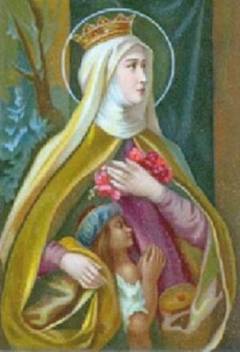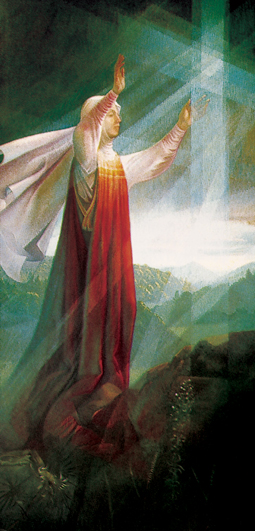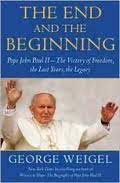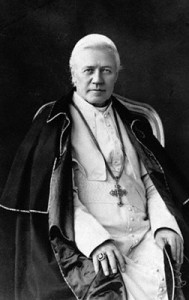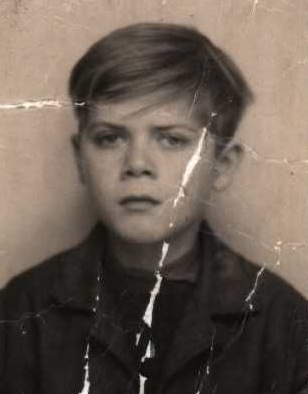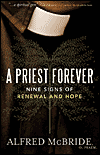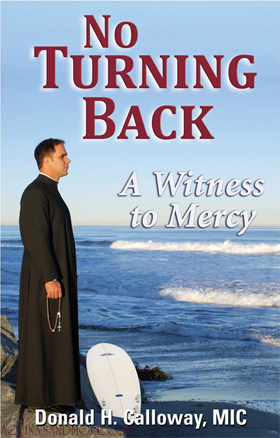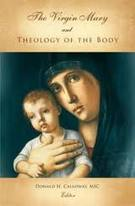From Pope Benedict’s General Wednesday Audience from Vatican.va
Dear Brothers and Sisters,
Today I would like to speak to you about one of the women of the Middle Ages who inspired the greatest admiration; she is St Elizabeth of Hungary, also called St Elizabeth of Thuringia.
Elizabeth was born in 1207; historians dispute her birthplace. Her father was Andrew ii, the rich and powerful King of Hungary. To reinforce political ties he had married the German Countess Gertrude of Andechs-Meran, sister of St Hedwig who was wife to the Duke of Silesia. Elizabeth, together with her sister and three brothers, spent only the first four years of her childhood at the Hungarian court. She liked playing, music and dancing; she recited her prayers faithfully and already showed special attention to the poor, whom she helped with a kind word or an affectionate gesture.
Her happy childhood was suddenly interrupted when some knights arrived from distant Thuringia to escort her to her new residence in Central Germany. In fact, complying with the customs of that time, Elizabeth’s father had arranged for her to become a Princess of Thuringia. The Landgrave or Count of this region was one of the richest and most influential sovereigns in Europe at the beginning of the 13th century and his castle was a centre of magnificence and culture.
However, the festivities and apparent glory concealed the ambition of feudal princes who were frequently warring with each other and in conflict with the royal and imperial authorities.
In this context the Landgrave Hermann very willingly accepted the betrothal of his son Ludwig to the Hungarian Princess. Elizabeth left her homeland with a rich dowry and a large entourage, including her personal ladies-in-waiting, two of whom were to remain faithful friends to the very end. It is they who left us the precious information on the childhood and life of the Saint.
They reached Eisenach after a long journey and made the ascent to the Fortress of Wartburg, the strong castle towering over the city. It was here that the betrothal of Ludwig and Elizabeth was celebrated. In the ensuing years, while Ludwig learned the knightly profession, Elizabeth and her companions studied German, French, Latin, music, literature and embroidery. Despite the fact that political reasons had determined their betrothal, a sincere love developed between the two young people, enlivened by faith and by the desire to do God’s will. On his father’s death when Ludwig was 18 years old, he began to reign over Thuringia.
Elizabeth, however, became the object of critical whispers because her behaviour was incongruous with court life. Hence their marriage celebrations were far from sumptuous and a part of the funds destined for the banquet was donated to the poor.
With her profound sensitivity, Elizabeth saw the contradictions between the faith professed and Christian practice. She could not bear compromise. Once, on entering a church on the Feast of the Assumption, she took off her crown, laid it before the Crucifix and, covering her face, lay prostrate on the ground. When her mother-in-law reprimanded her for this gesture, Elizabeth answered: “How can I, a wretched creature, continue to wear a crown of earthly dignity, when I see my King Jesus Christ crowned with thorns?â€.
She behaved to her subjects in the same way that she behaved to God. Among the Sayings of the four maids we find this testimony: “She did not eat any food before ascertaining that it came from her husband’s property or legitimate possessions. While she abstained from goods procured illegally, she also did her utmost to provide compensation to those who had suffered violence†(nn. 25 and 37).
She is a true example for all who have roles of leadership: the exercise of authority, at every level, must be lived as a service to justice and charity, in the constant search for the common good.
Elizabeth diligently practiced works of mercy: she would give food and drink to those who knocked at her door, she procured clothing, paid debts, cared for the sick and buried the dead. Coming down from her castle, she often visited the homes of the poor with her ladies-in-waiting, bringing them bread, meat, flour and other food. She distributed the food personally and attentively checked the clothing and mattresses of the poor.
This behaviour was reported to her husband, who not only was not displeased but answered her accusers, “So long as she does not sell the castle, I am happy with her!â€.
The miracle of the loaves that were changed into roses fits into this
context: while Elizabeth was on her way with her apron filled with bread for the poor, she met her husband who asked her what she was carrying. She opened her apron to show him and, instead of bread, it was full of magnificent roses. This symbol of charity often features in depictions of St Elizabeth.
Elizabeth’s marriage was profoundly happy: she helped her husband to raise his human qualities to a supernatural level and he, in exchange, stood up for his wife’s generosity to the poor and for her religious practices. Increasingly admired for his wife’s great faith, Ludwig said to her, referring to her attention to the poor: “Dear Elizabeth, it is Christ whom you have cleansed, nourished and cared forâ€. A clear witness to how faith and love of God and neighbour strengthen family life and deepen ever more the matrimonial union.
The young couple found spiritual support in the Friars Minor who began to spread through Thuringia in 1222. Elizabeth chose from among them Friar Rodeger (Rüdiger) as her spiritual director. When he told her about the event of the conversion of Francis of Assisi, a rich young merchant, Elizabeth was even more enthusiastic in the journey of her Christian life.
From that time she became even more determined to follow the poor and Crucified Christ, present in poor people. Even when her first son was born, followed by two other children, our Saint never neglected her charitable works. She also helped the Friars Minor to build a convent at Halberstadt, of which Friar Rodeger became superior. For this reason Elizabeth’s spiritual direction was taken on by Conrad of Marburg.
The farewell to her husband was a hard trial, when, at the end of June in 1227 when Ludwig ivjoined the Crusade of the Emperor Frederick ii. He reminded his wife that this was traditional for the sovereigns of Thuringia. Elizabeth answered him: “Far be it from me to detain you. I have given my whole self to God and now I must also give youâ€.
However, fever decimated the troops and Ludwig himself fell ill and died in Otranto, before embarking, in September 1227. He was 27 years old. When Elizabeth learned the news, she was so sorrowful that she withdrew in solitude; but then, strengthened by prayer and comforted by the hope of seeing him again in Heaven, she began to attend to the affairs of the Kingdom.
However, another trial was lying in wait for Elizabeth. Her brother-in-law usurped the government of Thuringia, declaring himself to be the true heir of Ludwig and accusing Elizabeth of being a pious woman incapable of ruling. The young widow, with three children, was banished from the Castle of Wartburg and went in search of a place of refuge. Only two of her ladies remained close to her. They accompanied her and entrusted the three children to the care of Ludwig’s friends. Wandering through the villages, Elizabeth worked wherever she was welcomed, looked after the sick, spun thread and cooked.
During this calvary which she bore with great faith, with patience and with dedication to God, a few relatives who had stayed faithful to her and viewed her brother-in-law’s rule as illegal, restored her reputation. So it was that at the beginning of 1228, Elizabeth received sufficient income to withdraw to the family’s castle in Marburg, where her spiritual director, Fra Conrad, also lived.
It was he who reported the following event to Pope Gregory ix: “On Good Friday in 1228, having placed her hands on the altar in the chapel of her city, Eisenach, to which she had welcomed the Friars Minor, in the presence of several friars and relatives Elizabeth renounced her own will and all the vanities of the world. She also wanted to resign all her possessions, but I dissuaded her out of love for the poor. Shortly afterwards she built a hospital, gathered the sick and invalids and served at her own table the most wretched and deprived. When I reprimanded her for these things, Elizabeth answered that she received from the poor special grace and humility†(Epistula magistri Conradi, 14-17).
We can discern in this affirmation a certain mystical experience similar to that of St Francis: thePoverello of Assisi declared in his testament, in fact, that serving lepers, which he at first found repugnant, was transformed into sweetness of the soul and of the body (Testamentum, 1-3).
Elizabeth spent her last three years in the hospital she founded, serving the sick and keeping wake over the dying. She always tried to carry out the most humble services and repugnant tasks. She became what we might call a consecrated woman in the world (soror in saeculo) and, with other friends clothed in grey habits, formed a religious community. It is not by chance that she is the Patroness of the Third Order Regular of St Francis and of the Franciscan Secular Order.
In November 1231 she was stricken with a high fever. When the news of her illness spread, may people flocked to see her. After about 10 days, she asked for the doors to be closed so that she might be alone with God. In the night of 17 November, she fell asleep gently in the Lord. The testimonies of her holiness were so many and such that after only four years Pope Gregory ixcanonized her and, that same year, the beautiful church built in her honour at Marburg was consecrated.
Dear brothers and sisters, in St Elizabeth we see how faith and friendship with Christ create a sense of justice, of the equality of all, of the rights of others and how they create love, charity. And from this charity is born hope too, the certainty that we are loved by Christ and that the love of Christ awaits us thereby rendering us capable of imitating Christ and of seeing Christ in others.
St Elizabeth invites us to rediscover Christ, to love him and to have faith; and thereby to find true justice and love, as well as the joy that one day we shall be immersed in divine love, in the joy of eternity with God. Thank you.
Tags: catholic, catholic podcast, catholic prayer, cathollc spirituality, Dear Elizabeth, elizabeth of thuringia, mystic, mystic of the Church, st elizabeth of hungary, st hedwig, st. elizabeth, women of the middle ages
This entry was posted on Wednesday, October 20th, 2010 at 8:48 pm
You can follow any responses to this entry through the RSS 2.0 feed.
Thank God for our Holy Father, Pope Benedict XVI, and his desire to teach us about the heritage contained in our faith. I love it now, because once again he is lifting up one of the truly gifted women mystics of the Church for all of us to learn from. I didn’t know much about her, until his teaching, but now…wow! What a story…I can’t wait to get to know her better! Blessed Angela, pray for us!
From the Pope Benedict’s Wednesday audience from vatican.va
Dear Brothers and Sisters,
Today I would like to speak to you about Blessed Angela of Foligno, a great medieval mystic who lived in the 13th century. People are usually fascinated by the consummate experience of union with God that she reached, but perhaps they give too little consideration to her first steps, her conversion and the long journey that led from her starting point, the “great fear of hell”, to her goal, total union with the Trinity. The first part of Angela’s life was certainly not that of a fervent disciple of the Lord. She was born into a well-off family in about 1248. Her father died and she was brought up in a somewhat superficial manner by her mother. She was introduced at a rather young age into the worldly circles of the town of Foligno, where she met a man whom she married at the age of 20 and to whom she bore children. Her life was so carefree that she was even contemptuous of the so-called “penitents”, who abounded in that period; they were people who, in order to follow Christ, sold their possessions and lived in prayer, fasting, in service to the Church and in charity.
Certain events, such as the violent earthquake in 1279, a hurricane, the endless war against Perugia and its harsh consequences, affected the life of Angela who little by little became aware of her sins, until she took a decisive step. In 1285 she called upon St Francis, who appeared to her in a vision and asked his advice on making a good general Confession. She then went to Confession with a Friar in San Feliciano. Three years later, on her path of conversion she reached another turning point: she was released from any emotional ties. In the space of a few months, her mother’s death was followed by the death of her husband and those of all her children. She therefore sold her possessions and in 1291 enrolled in the Third Order of St Francis. She died in Foligno on 4 January 1309.
The Book of Visions and Instructions of Blessed Angela of Foligno, in which is gathered the documentation on our Blessed, tells the story of this conversion and points out the necessary means: penance, humility and tribulation; and it recounts the steps, Angela’s successive experiences which began in 1285. Remembering them after she had experienced them, Angela then endeavoured to recount them through her Friar confessor, who faithfully transcribed them, seeking later to sort them into stages which he called “steps or mutations” but without managing to put them entirely in order (cf. Il Libro della beata Angela da Foligno, Cinisello Balsamo 1990, p. 51). This was because for Blessed Angela the experience of union meant the total involvement of both the spiritual and physical senses and she was left with only a “shadow” in her mind, as it were, of what she had “understood” during her ecstasies. “I truly heard these words”, she confessed after a mystical ecstasy, but it is in no way possible for me to know or tell of what I saw and understood, or of what he [God] showed me, although I would willingly reveal what I understood with the words that I heard, but it was an absolutely ineffable abyss”. Angela of Foligno presented her mystical “life”, without elaborating on it herself because these were divine illuminations that were communicated suddenly and unexpectedly to her soul. Her Friar confessor too had difficulty in reporting these events, “partly because of her great and wonderful reserve concerning the divine gifts” (ibid., p. 194). In addition to Angela’s difficulty in expressing her mystical experience was the difficulty her listeners found in understanding her. It was a situation which showed clearly that the one true Teacher, Jesus, dwells in the heart of every believer and wants to take total possession of it. So it was with Angela, who wrote to a spiritual son: “My son, if you were to see my heart you would be absolutely obliged to do everything God wants, because my heart is God’s heart and God’s heart is mine”. Here St Paul’s words ring out: “It is no longer I who live, but Christ who lives in me” (Gal 2: 20).
Let us then consider only a few “steps” of our Blessed’s rich spiritual journey. The first, in
fact, is an introduction: “It was the knowledge of sin”, as she explained, “after which my soul was deeply afraid of damnation; in this stage I shed bitter tears” (Il Libro della beata Angela da Foligno, p. 39). This “dread” of hell corresponds to the type of faith that Angela had at the time of her “conversion”; it was a faith still poor in charity, that is, in love of God. Repentance, the fear of hell and penance unfolded to Angela the prospect of the sorrowful “Way of the Cross”, which from the eighth to the 15th stages was to lead her to the “way of love”. Her Friar confessor recounted: “The faithful woman then told me: I have had this divine revelation: “after the things you have written, write that anyone who wishes to preserve grace must not lift the eyes of his soul from the Cross, either in the joy or in the sadness that I grant or permit him'” (ibid., p. 143). However, in this phase Angela “did not yet feel love”. She said: “The soul feels shame and bitterness and does not yet feel love but suffering” (ibid., p. 39), and is unrequited.
Angela felt she should give something to God in reparation for her sins, but slowly came to realize that she had nothing to give him, indeed, that she “was nothing” before him. She understood that it would not be her will to give her God’s love, for her will could give only her own “nothingness”, her “non-love”. As she was to say: only “true and pure love, that comes from God, is in the soul and ensures that one recognizes one’s own shortcomings and the divine goodness…. Such love brings the soul to Christ and it understands with certainty that in him no deception can be found or can exist. No particle of worldly love can be mingled with this love” (ibid., p. 124-125). This meant opening herself solely and totally to God’s love whose greatest expression is in Christ: “O my God” she prayed, “make me worthy of knowing the loftiest mystery that your most ardent and ineffable love brought about for our sake, together with the love of the Trinity, in other words the loftiest mystery of your most holy Incarnation…. O incomprehensible love! There is no greater love than this love that brought my God to become man in order to make me God” (ibid., p. 295). However, Angela’s heart always bore the wounds of sin; even after a good Confession she would find herself forgiven and yet still stricken by sin, free and yet conditioned by the past, absolved but in need of penance. And the thought of hell accompanied her too, for the greater the progress the soul made on the way of Christian perfection, the more convinced it is not only of being “unworthy” but also deserving of hell.
And so it was that on this mystical journey Angela understood the central reality in a profound way: what would save her from her “unworthiness” and from “deserving hell” would not be her “union with God” or her possession of the “truth” but Jesus Crucified, “his crucifixion for me”, his love.
In the eighth step, she said, “However, I did not yet understand whether my liberation from sins and from hell and conversion to penance was far greater, or his crucifixion for me” (ibid., n. 41). This was the precarious balance between love and suffering, that she felt throughout her arduous journey towards perfection. For this very reason she preferred to contemplate Christ Crucified, because in this vision she saw the perfect balance brought about. On the Cross was the man-God, in a supreme act of suffering which was a supreme act of love. In the third Instruction the Blessed insisted on this contemplation and declared: “The more perfectly and purely we see, the more perfectly and purely we love…. Therefore the more we see the God and man, Jesus Christ, the more we are transformed in him through love…. What I said of love… I also say of suffering: the more the soul contemplates the ineffable suffering of the God and man Jesus Christ the more sorrowful it becomes and is transformed through suffering” (ibid., p. 190-191). Thus, unifying herself with and transforming herself into the love and suffering of Christ Crucified, she was identifying herself with him. Angela’s conversion, which began from that Confession in 1285, was to reach maturity only when God’s forgiveness appeared to her soul as the freely given gift of the love of the Father, the source of love: “No one can make excuses”, she said, “because anyone can love God and he does not ask the soul for more than to love him, because he loves the soul and it is his love” (ibid., p. 76).On Angela’s spiritual journey the transition from conversion to mystical experience, from what can be expressed to the inexpressible, took place through the Crucified One. He is the “God-man of the Passion”, who became her “teacher of perfection”. The whole of her mystical experience, therefore, consisted in striving for a perfect “likeness” with him, through ever deeper and ever more radical purifications and transformations. Angela threw her whole self, body and soul, into this stupendous undertaking, never sparing h
erself of penance and suffering, from beginning to end, desiring to die with all the sorrows suffered by the God-man crucified in order to be totally transformed in him. “O children of God”, she recommended, “transform yourselves totally in the man-God who so loved you that he chose to die for you a most ignominious and all together unutterably painful death, and in the most painful and bitterest way. And this was solely for love of you, O man!” (ibid., p. 247). This identification also meant experiencing what Jesus himself experienced: poverty, contempt and sorrow, because, as she declared, “through temporal poverty the soul will find eternal riches; through contempt and shame it will obtain supreme honour and very great glory; through a little penance, made with pain and sorrow, it will possess with infinite sweetness and consolation the Supreme Good, Eternal God” (ibid., p. 293).
From conversion to mystic union with Christ Crucified, to the inexpressible. A very lofty journey, whose secret is constant prayer. “The more you pray”, she said, “the more illumined you will be and the more profoundly and intensely you will see the supreme Good, the supremely good Being; the more profoundly and intensely you see him, the more you will love him; the more you love him the more he will delight you; and the more he delights you, the better you will understand him and you will become capable of understanding him. You will then reach the fullness of light, for you will understand that you cannot understand” (ibid., p. 184).
Dear brothers and sisters, Blessed Angela’s life began with a worldly existence, rather remote from God. Yet her meeting with the figure of St Francis and, finally, her meeting with Christ Crucified reawakened her soul to the presence of God, for the reason that with God alone life becomes true life, because, in sorrow for sin, it becomes love and joy. And this is how Blessed Angela speaks to us. Today we all risk living as though God did not exist; he seems so distant from daily life. However, God has thousands of ways of his own for each one, to make himself present in the soul, to show that he exists and knows and loves me. And Blessed Angela wishes to make us attentive to these signs with which the Lord touches our soul, attentive to God’s presence, so as to learn the way with God and towards God, in communion with Christ Crucified. Let us pray the Lord that he make us attentive to the signs of his presence and that he teach us truly to live. Thank you.
Tags: Blessed Angela, catholic, catholic podcast, catholic prayer, catholic saints, cathollc spirituality, holy father, mystic, mystics of the church, pope benedict xvi, prayer, women of the middle ages
This entry was posted on Thursday, October 14th, 2010 at 1:46 pm
You can follow any responses to this entry through the RSS 2.0 feed.
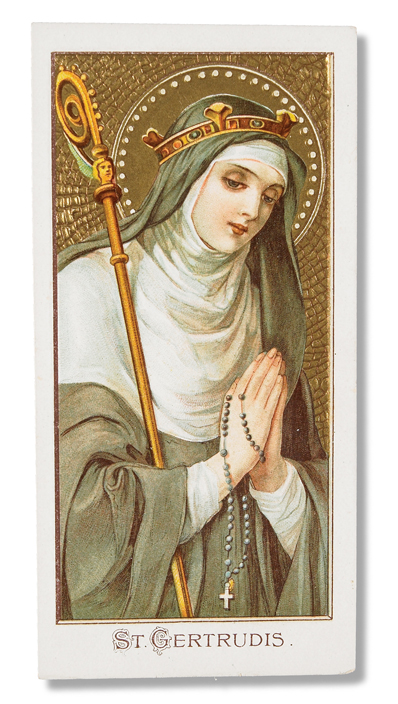
BENEDICT XVI GENERAL AUDIENCE (the entire text translated in English) from vatican.va
Dear Brothers and Sisters,
St Gertrude the Great, of whom I would like to talk to you today, brings us once again this week to the Monastery of Helfta, where several of the Latin-German masterpieces of religious literature were written by women. Gertrude belonged to this world. She is one of the most famous mystics, the only German woman to be called “Great”, because of her cultural and evangelical stature: her life and her thought had a unique impact on Christian spirituality. She was an exceptional woman, endowed with special natural talents and extraordinary gifts of grace, the most profound humility and ardent zeal for her neighbour’s salvation. She was in close communion with God both in contemplation and in her readiness to go to the help of those in need.
At Helfta, she measured herself systematically, so to speak, with her teacher, Matilda of Hackeborn, of whom I spoke at last Wednesday’s Audience. Gertrude came into contact with Matilda of Magdeburg, another medieval mystic and grew up under the wing of Abbess Gertrude, motherly, gentle and demanding. From these three sisters she drew precious experience and wisdom; she worked them into a synthesis of her own, continuing on her religious journey with boundless trust in the Lord. Gertrude expressed the riches of her spirituality not only in her monastic world, but also and above all in the biblical, liturgical, Patristic and Benedictine contexts, with a highly personal hallmark and great skill in communicating.
Gertrude was born on 6 January 1256, on the Feast of the Epiphany, but nothing is known of her parents nor of the place of her birth. Gertrude wrote that the L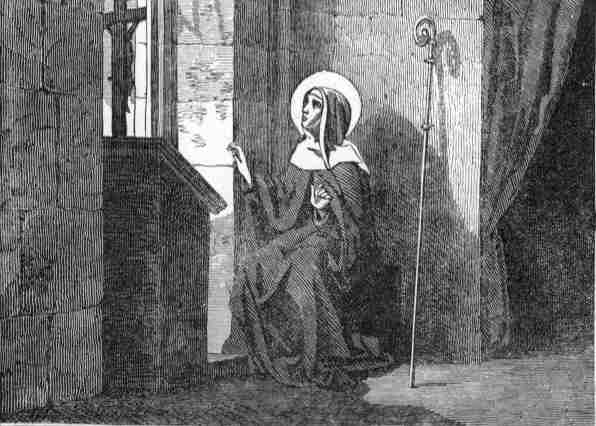 ord himself revealed to her the meaning of this first uprooting: “I have chosen you for my abode because I am pleased that all that is lovable in you is my work…. For this very reason I have distanced you from all your relatives, so that no one may love you for reasons of kinship and that I may be the sole cause of the affection you receive” (The Revelations, I, 16, Siena 1994, pp. 76-77).
ord himself revealed to her the meaning of this first uprooting: “I have chosen you for my abode because I am pleased that all that is lovable in you is my work…. For this very reason I have distanced you from all your relatives, so that no one may love you for reasons of kinship and that I may be the sole cause of the affection you receive” (The Revelations, I, 16, Siena 1994, pp. 76-77).
When she was five years old, in 1261, she entered the monastery for formation and education, a common practice in that period. Here she spent her whole life, the most important stages of which she herself points out. In her memoirs she recalls that the Lord equipped her in advance with forbearing patience and infinite mercy, forgetting the years of her childhood, adolescence and youth, which she spent, she wrote, “in such mental blindness that I would have been capable… of thinking, saying or doing without remorse everything I liked and wherever I could, had you not armed me in advance, with an inherent horror of evil and a natural inclination for good and with the external vigilance of others. “I would have behaved like a pagan… in spite of desiring you since childhood, that is since my fifth year of age, when I went to live in the Benedictine shrine of religion to be educated among your most devout friends” (ibid., II, 23, p. 140f.).
Gertrude was an extraordinary student, she learned everything that can be learned of the sciences of the trivium and quadrivium, the education of that time; she was fascinated by knowledge and threw herself into profane studies with zeal and tenacity, achieving scholastic successes beyond every expectation. If we know nothing of her origins, she herself tells us about her youthful passions: literature, music and song and the art of miniature painting captivated her. She had a strong, 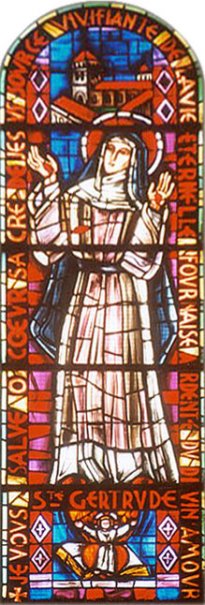 determined, ready and impulsive temperament. She often says that she was negligent; she recognizes her shortcomings and humbly asks forgiveness for them. She also humbly asks for advice and prayers for her conversion. Some features of her temperament and faults were to accompany her to the end of her life, so as to amaze certain people who wondered why the Lord had favoured her with such a special love.
determined, ready and impulsive temperament. She often says that she was negligent; she recognizes her shortcomings and humbly asks forgiveness for them. She also humbly asks for advice and prayers for her conversion. Some features of her temperament and faults were to accompany her to the end of her life, so as to amaze certain people who wondered why the Lord had favoured her with such a special love.
From being a student she moved on to dedicate herself totally to God in monastic life, and for 20 years nothing exceptional occurred: study and prayer were her main activities. Because of her gifts she shone out among the sisters; she was tenacious in consolidating her culture in various fields.
Nevertheless during Advent of 1280 she began to feel disgusted with all this and realized the vanity of it all. On 27 January 1281, a few days before the Feast of the Purification of the Virgin, towards the hour of Compline in the evening, the Lord with his illumination dispelled her deep anxiety. With gentle sweetness he calmed the distress that anguished her, a torment that Gertrude saw even as a gift of God, “to pull down that tower of vanity and curiosity which, although I had both the name and habit of a nun alas I had continued to build with my pride, so that at least in this manner I might find the way for you to show me your salvation” (ibid., II, p. 87). She had a vision of a young man who, in order to guide her through the tangle of thorns that surrounded her soul, took her by the hand. In that hand Gertrude recognized “the precious traces of the wounds that abrogated all the acts of accusation of our enemies” (ibid., II, 1, p. 89), and thus recognized the One who saved us with his Blood on the Cross: Jesus.
From that moment her life of intimate communion with the Lord was intensified, especially in the most important liturgical seasons Advent-Christmas, Lent-Easter, the feasts of Our Lady even when illness prevented her from going to the choir. This was the same liturgical humus as that of Matilda, her teacher; but Gertrude describes it with simpler, more linear images, symbols and terms that are more realistic and her references to the Bible, to the Fathers and to the Benedictine world are more direct.
Her biographer points out two directions of what we might describe as her own particular “conversion“: in study, with the radical passage from profane, humanistic studies to the study of theology, and in monastic observance, with the passage from a life that she describes as negligent, to the life of intense, mystical prayer, with exceptional missionary zeal. The Lord who had chosen her from her mother’s womb and who since her childhood had made her partake of the banquet of monastic life, called her again with his grace “from external things to inner life and from earthly occupations to love for spiritual things”. Gertrude understood that she was remote from him, in the region of unlikeness, as she said with Augustine; that she had dedicated herself with excessive greed to liberal studies, to human wisdom, overlooking spiritual knowledge, depriving herself of the taste for true wisdom; she was then led to the mountain of contemplation where she cast off her former self to be reclothed in the new. “From a grammarian she became a theologian, with the unflagging and attentive reading of all the sacred books that she could lay her hands on or contrive to obtain. She filled her heart with the most useful and sweet sayings of Sacred Scripture. Thus she was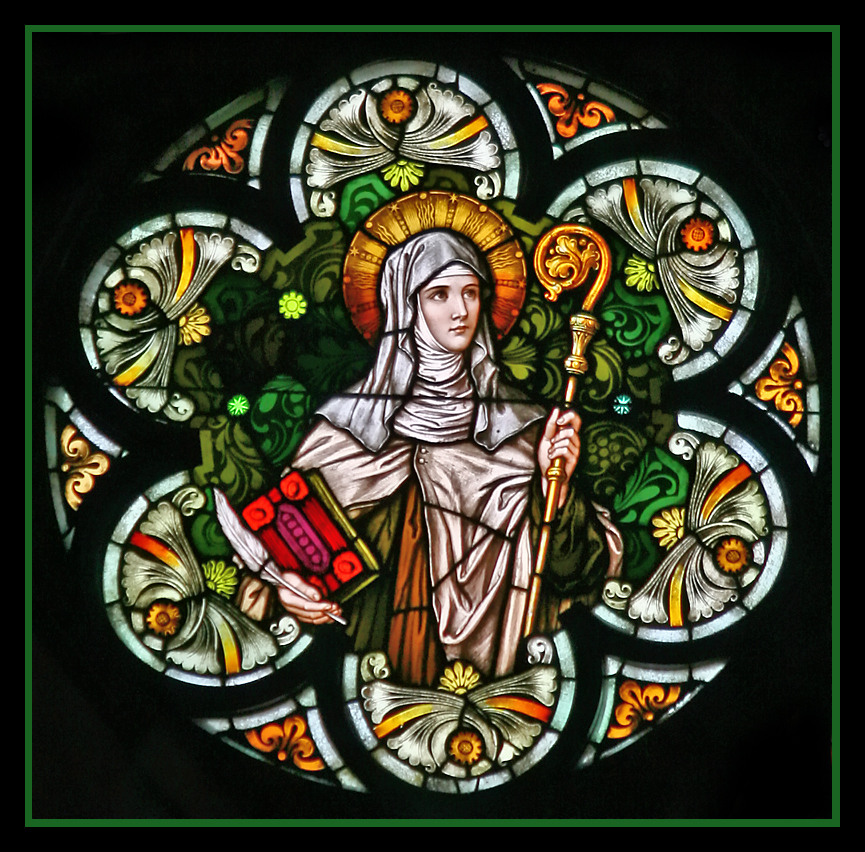 always ready with some inspired and edifying word to satisfy those who came to consult her while having at her fingertips the most suitable scriptural texts to refute any erroneous opinion and silence her opponents” (ibid., I, 1, p. 25).
always ready with some inspired and edifying word to satisfy those who came to consult her while having at her fingertips the most suitable scriptural texts to refute any erroneous opinion and silence her opponents” (ibid., I, 1, p. 25).
Gertrude transformed all this into an apostolate: she devoted herself to writing and popularizing the truth of faith with clarity and simplicity, with grace and persuasion, serving the Church faithfully and lovingly so as to be helpful to and appreciated by theologians and devout people.
Little of her intense activity has come down to us, partly because of the events that led to the destruction of the Monastery of Helfta. In addition to The Herald of Divine Love and The Revelations, we still have her Spiritual Exercises, a rare jewel of mystical spiritual literature.
In religious observance our Saint was “a firm pillar… a very powerful champion of justice and truth” (ibid., I, 1, p. 26), her biographer says. By her words and example she kindled great fervour in other people. She added to the prayers and penances of the monastic rule others with such devotion and such trusting abandonment in God that she inspired in those who met her an awareness of being in the Lord’s presence. In fact, God made her understand that he had called her to be an instrument of his grace. Gertrude herself felt unworthy of this immense divine treasure, and confesses that she had not safeguarded it or made enough of it. She exclaimed: “Alas! If you had given me to remember you, unworthy as I am, by even only a straw, I would have viewed it with greater respect and reverence that I have had for all your gifts!” (ibid., II, 5, p. 100). Yet, in recognizing her poverty and worthlessness she adhered to God’s will, “because”, she said, “I have so little profited from your graces that I cannot resolve to believe that they were lavished upon me solely for my own use, since no one can thwart your eternal wisdom. Therefore, O Giver of every good thing who has freely lavished upon me gifts so undeserved, in order that, in reading this, the heart of at least one of your friends may be moved at the thought that zeal for souls has induced you to leave such a priceless gem for so long in the abominable mud of my heart” (ibid., II, 5, p. 100f.).
Two favours in particular were dearer to her than any other, as Gertrude herself writes: “The stigmata of your salvation-bearing wounds which you impressed upon me, as it were, like a valuable necklaces, in my heart, and the profound and salutary wound of love with which you marked it. “You flooded me with your gifts, of such beatitude that even were I to live for 1,000 years with no consolation neither interior nor exterior the memory of them would suffice to comfort me, to enlighten me, to fill me with gratitude. 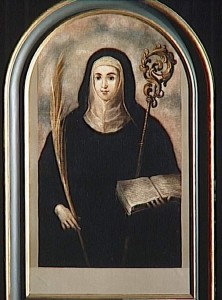 Further, you wished to introduce me into the inestimable intimacy of your friendship by opening to me in various ways that most noble sacrarium of your Divine Being which is your Divine Heart…. To this accumulation of benefits you added that of giving me as Advocate the Most Holy Virgin Mary, your Mother, and often recommended me to her affection, just as the most faithful of bridegrooms would recommend his beloved bride to his own mother” (ibid., II, 23, p. 145).
Further, you wished to introduce me into the inestimable intimacy of your friendship by opening to me in various ways that most noble sacrarium of your Divine Being which is your Divine Heart…. To this accumulation of benefits you added that of giving me as Advocate the Most Holy Virgin Mary, your Mother, and often recommended me to her affection, just as the most faithful of bridegrooms would recommend his beloved bride to his own mother” (ibid., II, 23, p. 145).
Looking forward to never-ending communion, she ended her earthly life on 17 November 1301 or 1302, at the age of about 46. In the seventh Exercise, that of preparation for death, St Gertrude wrote: “O Jesus, you who are immensely dear to me, be with me always, so that my heart may stay with you and that your love may endure with me with no possibility of division; and bless my passing, so that my spirit, freed from the bonds of the flesh, may immediately find rest in you. Amen” (Spiritual Exercises, Milan 2006, p. 148).
It seems obvious to me that these are not only things of the past, of history; rather St Gertrude’s life lives on as a lesson of Christian life, of an upright path, and shows us that the heart of a happy life, of a true life, is friendship with the Lord Jesus. And this friendship is learned in love for Sacred Scripture, in love for the Liturgy, in profound faith, in love for Mary, so as to be ever more truly acquainted with God himself and hence with true happiness, which is the goal of our life. Many thanks.
Tags: benedict xvi, catholic, catholic podcast, catholic prayer, cathollc spirituality, contemplation, famous mystics, heart, love, mystic, mystic of the Church, mystical experiences, sacred scripture, st gertrude, truth, women of the middle ages
This entry was posted on Wednesday, October 6th, 2010 at 6:47 pm
You can follow any responses to this entry through the RSS 2.0 feed.
Describing the exemplary life of a 13th-century German nun, Pope Benedict XVI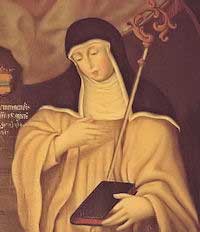 stressed the importance of liturgy in building a close relationship with God.
stressed the importance of liturgy in building a close relationship with God.
VATICAN CITY, 29 SEP 2010 Â Pope Benedict’s General Audience vatican.va
Dear Brothers and Sisters,
Today I want to talk to you about St Matilda of Hackeborn, one of the great figures of the convent of Helfta, who lived in the 13th century. Her sister, St Gertrude the Great, tells of the special graces that God granted to St Matilda in the sixth book of Liber Specialis Gratiae (Book of Special Grace), which states : “What we have written is very little in comparison with what we have omitted. We are publishing these things solely for the glory of God and the usefulness of our neighbour, for it would seem wrong to us to keep quiet about the many graces that Matilda received from God, not so much for herself, in our opinion, but for us and for those who will come after us” (Mechthild von Hackeborn, Liber specialis gratiae, vi, 1).
This work was written by St Gertrude and by another sister of Helfta and has a unique story. At the age of 50, Matilda went through a grave spiritual crisis, as well as physical suffering. In this condition she confided to two of her sisters who were friends the special graces with which God had guided her since childhood. However, she did not know that they were writing it all down. When she found out she was deeply upset and distressed. However, the Lord reassured her, making her realize that all that had been written was for the glory of God and for the benefit of her neighbour (cf. ibid., II, 25; V, 20). This work, therefore, is the principal source to refer to for information on the life and spirituality of our Saint.
With her we are introduced into the family of Baron von Hackeborn, one of the noblest, richest and most powerful barons of Thuringia, related to the Emperor Frederick ii, and we enter the convent of Helfta in the most glorious period of its history. The Baron had already given one daughter to the convent, Gertrude of Hackeborn (1231/1232 – 1291/1292). She was gifted with an outstanding personality. She was Abbess for 40 years, capable of giving the spirituality of the convent a particular hallmark and of bringing it to an extraordinary flourishing as the centre of mysticism and culture, a school for scientific and theological training. Gertrude offered the nuns an intellectual training of a high standard that enabled them to cultivate a spirituality founded on Sacred Scripture, on the Liturgy, on the Patristic tradition, on the Cistercian Rule and spirituality, with a particular love for St Bernard of Clairvaux and William of Saint-Thierry. She was a real teacher, exemplary in all things, in evangelical radicalism and in apostolic zeal. Matilda, from childhood, accepted and enjoyed the spiritual and cultural atmosphere created by her sister, later giving it her own personal hallmark.
Matilda was born in 1241 or 1242 in the Castle of Helfta. She was the Baron’s third daughter. When she was seven she went with her mother to visit her sister Gertrude in the convent of Rodersdorf. She was so enchanted by this environment that she ardently desired to belong to it. She entered as a schoolgirl and in 1258 became a nun at the convent, which in the meantime had moved to Helfta, to the property of the Hackeborns. She was distinguished by her humility, her fervour, her friendliness, the clarity and the innocence of her life and by the familiarity and intensity with which she lived her relationship with God, the Virgin and the Saints. She was endowed with lofty natural and spiritual qualities such as knowledge, intelligence, familiarity with the humanities and a marvellously sweet voice: everything suited her to being a true treasure for the convent from every point of view (ibid, Proem.). Thus when “God’s nightingale”, as she was called, was still very young she became the principal of the convent’s school, choir mistress and novice mistress, offices that she fulfilled with talent and unflagging zeal, not only for the benefit of the nuns but for anyone who wanted to draw on her wisdom and goodness.
Illumined by the divine gift of mystic contemplation, Matilda wrote many prayers. She was a teacher of faithful doctrine and deep humility, a counsellor, comforter and guide in discernment. We read: “she distributed doctrine in an abundance never previously seen at the convent, and alas, we are rather afraid that nothing like it will ever be seen again. The sisters would cluster round her to hear the word of God, as if she were a preacher. “She was the refuge and consoler of all and, by a unique gift of God, was endowed with the grace of being able to reveal freely the secrets of the heart of each one. Many people, not only in the convent but also outsiders, religious and lay people, who came from afar, testified that this holy virgin had freed them from their afflictions and that they had never known such comfort as they found near her. “Furthermore, she composed and taught so many prayers that if they were gathered together they would make a book larger than a Psalter” (ibid., VI, 1).
In 1261 a five year old girl came to the convent. Her name was Gertrude: She was entrusted to the care of Matilda, just 20 years of age, who taught her and guided her in the spiritual life until she not only made her into an excellent disciple but also her confidant. In 1271 or 1272, Matilda of Magdeburg also entered the convent. So it was that this place took in four great women two Gertrudes and two Matildas the glory of German monasticism. During her long life which she spent in the convent, Matilda was afflicted with continuous and intense bouts of suffering, to which she added the very harsh penances chosen for the conversion of sinners. In this manner she participated in the Lord’s Passion until the end of her life (cf. ibid., VI, 2).
Prayer and contemplation were the life-giving humus of her existence: her revelations, her teachings, her service to her neighbour, her journey in faith and in love have their root and their context here.
In the first book of the work,Liber Specialis Gratiae, the nuns wrote down Matilda’s confidences pronounced on the Feasts of the Lord, the Saints and, especially, of the Blessed Virgin. This Saint had a striking capacity for living the various elements of the Liturgy, even the simplest, and bringing it into the daily life of the convent. Some of her images, expressions and applications are at times distant from our sensibility today, but, if we were to consider monastic life and her task as mistress and choir mistress, we should grasp her rare ability as a teacher and educator who, starting from the Liturgy, helped her sisters to live intensely every moment of monastic life.
Matilda gave an emphasis in liturgical prayer to the canonical hours, to the celebrations of Holy Mass and, especially, to Holy Communion. Here she was often rapt in ecstasy in profound intimacy with the Lord in his most ardent and sweetest Heart, carrying on a marvellous conversation in which she asked for inner illumination, while interceding in a special way for her community and her sisters. At the centre are the mysteries of Christ which the Virgin Mary constantly recommends to people so that they may walk on the path of holiness: “If you want true holiness, be close to my Son; he is holiness itself that sanctifies all things” (ibid., I, 40). The whole world, the Church, benefactors and sinners were present in her intimacy with God. For her, Heaven and earth were united.
Her visions, her teachings, the events of her life are described in words reminiscent of liturgical and biblical language. In this way it is possible to comprehend her deep knowledge of Sacred Scripture, which was her daily bread. She had constant recourse to the Scriptures, making the most of the biblical texts read in the Liturgy, and drawing from them symbols, terms, countryside, images and famous figures. She had a special love for the Gospel: “The words of the Gospel were a marvellous nourishment for her and in her heart stirred feelings of such sweetness that, because of her enthusiasm, she was often unable to finish reading it…. The way in which she read those words was so fervent that it inspired devotion in everyone. “Thus when she was singing in the choir, she was completely absorbed in God, uplifted by such ardour that she sometimes expressed her feelings in gestures…. “On other occasions, since she was rapt in ecstasy, she did not hear those who were calling or touching her and came back with difficulty to the reality of the things around her” (ibid., VI, 1). In one of her visions, Jesus himself recommended the Gospel to her; opening the wound in his most gentle Heart, he said to her: “consider the immensity of my love: if you want to know it well, nowhere will you find it more clearly expressed than in the Gospel. No one has ever heard expressed stronger or more tender sentiments than these:Â “As my father has loved me, so I have loved you (Jn 15: 9)'” (ibid., I, 22).
Dear friends, personal and liturgical prayer, especially the Liturgy of the Hours and Holy Mass are at the root of St Matilda of Hackeborn’s spiritual experience. In letting herself be guided by Sacred Scripture and nourished by the Bread of the Eucharist, she followed a path of close union with the Lord, ever in full fidelity to the Church. This is also a strong invitation to us to intensify our friendship with the Lord, especially through daily prayer and attentive, faithful and active participation in Holy Mass. The Liturgy is a great school of spirituality.
Her disciple Gertrude gives a vivid pictures of St Matilda of Hackeborn’s last moments. They were very difficult but illumined by the presence of the Blessed Trinity, of the Lord, of the Virgin Mary and of all the Saints, even Gertrude’s sister by blood. When the time came in which the Lord chose to gather her to him, she asked him let her live longer in suffering for the salvation of souls, and Jesus was pleased with this further sign of her love.
Matilda was 58 years old. The last leg of her journey was marked by eight years of serious illness. Her work and the fame of her holiness spread far and wide. When her time came, “the God of majesty… the one delight of the soul that loves him… sang to her:Â Venite vos, benedicti Patris mei…. Venite, o voi che siete i benedetti dal Padre mio, venite a ricevere il regno… and he united her with his glory” (ibid., VI, 8).
May St Matilda of Hackeborn commend us to the Sacred Heart of Jesus and to the Virgin Mary. She invites us to praise the Son with the Heart of the Mother, and to praise Mary with the Heart of the Son: “I greet you, O most deeply venerated Virgin, in that sweetest of dews which from the Heart of the Blessed Trinity spread within you; I greet you in the glory and joy in which you now rejoice for ever, you who were chosen in preference to all the creatures of the earth and of Heaven even before the world’s creation! Amen” (ibid., I, 45).
Tags: benedict xvi, catholic, catholic podcast, catholic prayer, cathollc spirituality, cistercians, discernment, holy father, holy virgin, matilda, mystic, mystic of the Church, patristic tradition, st gertrude, women of the middle ages
This entry was posted on Sunday, October 3rd, 2010 at 12:44 am
You can follow any responses to this entry through the RSS 2.0 feed.
 George Weigel give us “The End and The Beginning: Pope John Paul II – The Victory of of Freedom, The Last Years, The Legacy”. What a tremendous blessing to reflect once again on the life of a modern day saint…our very own late great Holy Father, John Paul II. George Weigel doesn’t disappoint. The first part of the book reads like a spy novel…even more compelling because it’s true. The second part, covers the last 6 years of the Pope John Paul’s life, the jubilee and so much more. The last part sets the stage for a legacy which will be reflected and pondered on for generations, if not centuries. It’s as much our story as Church as it is the life of  Pope John Paul II. Don’t miss this one…it is essential reading!!!
George Weigel give us “The End and The Beginning: Pope John Paul II – The Victory of of Freedom, The Last Years, The Legacy”. What a tremendous blessing to reflect once again on the life of a modern day saint…our very own late great Holy Father, John Paul II. George Weigel doesn’t disappoint. The first part of the book reads like a spy novel…even more compelling because it’s true. The second part, covers the last 6 years of the Pope John Paul’s life, the jubilee and so much more. The last part sets the stage for a legacy which will be reflected and pondered on for generations, if not centuries. It’s as much our story as Church as it is the life of  Pope John Paul II. Don’t miss this one…it is essential reading!!!
Visit the Ethic and Public Policy Center for more information
Tags: catholic, catholic podcast, catholic prayer, cathollc spirituality, doubleday religion, ethic and public policy center, george weigel, life of pope john paul ii, pope john paul, pope john paul ii, random house
This entry was posted on Tuesday, September 21st, 2010 at 12:42 am
You can follow any responses to this entry through the RSS 2.0 feed.
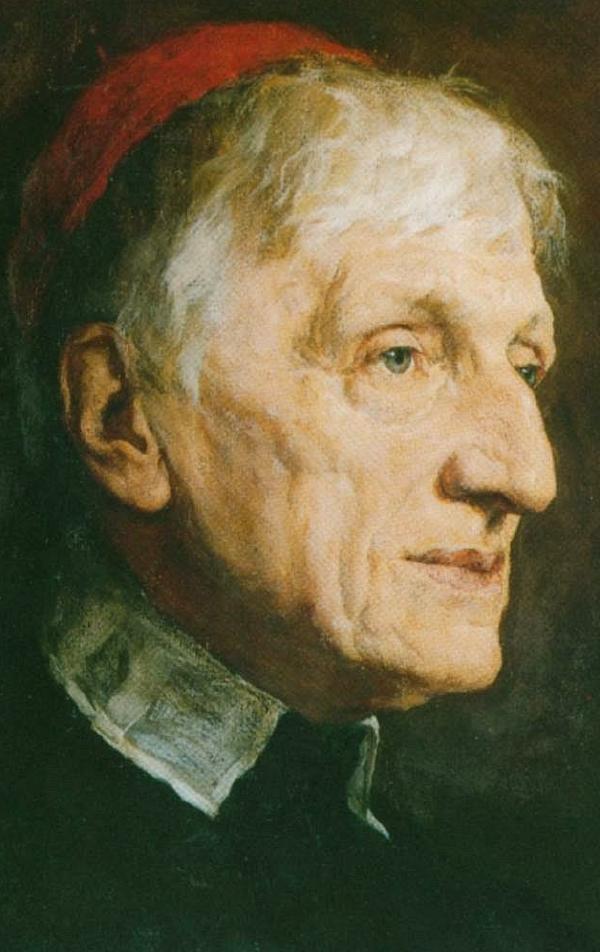 “Much loved father of souls…” Pope Benedict XVI
“Much loved father of souls…” Pope Benedict XVI
As reported by the Catholic Herald UK
Pope Benedict XVI today beatified Cardinal John Henry Newman in a historic Mass at Cofton Park, Birmingham – the first beatification ever to take place on British soil.
In his homily, the Pope placed Cardinal Newman in a tradition of English martyrs and saintly scholars, and praised the “warmth and humanity†of his priestly ministry.
He also noted that it was the 70th anniversary of the Battle of Britain, and paid tribute to English men and women who resisted the “evil ideology†of Nazism.
He said: “For me as one who lived and suffered through the dark days of the Nazi regime in Germany, it is deeply moving to be here with you on this occasion, and to recall how many of your fellow citizens sacrificed their lives, courageously resisting the forces of that evil ideology.
“My thoughts go in particular to nearby Coventry, which suffered such heavy bombardment and massive loss of life in November 1940,†the Pope said.
He explained Newman was the latest in a “long line†of saintly British scholars, including St Bede, St Hilda, St Aelred, and Blessed Duns Scotus. It was a tradition, he said, “of gentle scholarship, deep human wisdom and profound love for the Lordâ€.
He pointed to Newman’s “devoted care for the people of Birmingham … visiting the sick and the poor, comforting the bereaved, caring for those in prisonâ€.
“No wonder,†he said, “that on his death so many thousands of people lined the local streets as his body was taken to its place of burial not half a mile from hereâ€.
The Pope said that given his holiness it was fitting he should take his place beside England’s martyrs, “whose courageous witness has sustained and inspired the Catholic community here for centuriesâ€.
Pope Benedict said his vision of education had “done so much to shape the ethos that is the driving force behind Catholic schools and colleges todayâ€.
He quoted Cardinal Newman’s appeal for a well-instructed laity as a goal for all teachers of religion. He said: “ ‘I want a laity not arrogant, not rash in speech, not disputatious, but men who know their religion, who enter into it, who know just where they stand, who know what they hold and what they do not, who know their creed so well that they can give an account of it, who know so much of history that they can defend it.’ â€
The Pope added: “I pray that, through his intercession and example, all who are engaged in the task of teaching and catechesis will be inspired to greater effort by the vision he so clearly sets before us.â€
He also spoke about Newman’s holiness, saying it was a “profound desire of the human heart to enter into intimate communion with the Heart of Godâ€.
The Pope spoke in front of tens of thousands of pilgrims, some of whom had slept overnight at Cofton Park in sleeping bags. Others had set off from parishes as early as 2am in special pilgrim buses. Fr Tim Finigan, parish priest at Blackfen, Kent, tweeted: “Apologies to the neighbours for waking them up last night singing ‘God bless our Pope’ as the coach left for Birmingham. Won’t happen again.â€
According to Simon Caldwell, the Catholic Herald’s news editor, rain poured down all morning until just before the Pope’s helicopter landed nearby, when the sun finally came out.
Deacon Jack Sullivan, who was healed of a severe spinal disorder after praying for Newman’s intercession, proclaimed the Gospel during the Mass. It was his inexplicable healing that led to Newman being made a Blessed.
A choir of 1,200 sung a new setting of the Mass by composer James MacMillan. The prayers of the faithful were made in German, Welsh, French, Vietnamese and Punjabi.” – Catholic Herald UK
Tags: catholic, catholic podcast, catholic prayer, cathollc spirituality, john henry newman, pope benedict xvi
This entry was posted on Sunday, September 19th, 2010 at 9:32 pm
You can follow any responses to this entry through the RSS 2.0 feed.
Pope Benedict XVI and the Sexual Abuse Scandal is an important contribution to the understanding and healin g of the great heartache that has inflicted the Church over the last 30 years. Talking with Gregory Erlandson was a great opportunity to realize the nuisances of what got us here, but also the response and hope that leads us to the future.
g of the great heartache that has inflicted the Church over the last 30 years. Talking with Gregory Erlandson was a great opportunity to realize the nuisances of what got us here, but also the response and hope that leads us to the future.
The wonderful David Scott, put it best:
This is Catholic journalism at its best. Erlandson and Bunson are two of most knowledgeable people in the world on the Church and this book shows it. Good reporting, sharply written, smart analysis, not afraid of the hard questions–even if the answers don’t always put the Church in the best light. This book should be in every mainstream newsroom in the country. It offers a definitive historical overview of the abuse scandal and Pope Benedict’s role, first as head of the Vatican’s doctrine office and now as Pope. This should be an eye-opener for those who think Benedict has been negligent or worse. The facts just don’t support the conclusions that the mainstream media has been insisting upon. In addition to good reporting, this book provides excellent documentation–full texts of every reference Benedict has made on the crisis, including his addresses to the 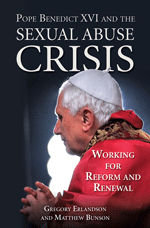 U.S. bishops and his historic letter to the people of Ireland. A good read and an essential reference.
U.S. bishops and his historic letter to the people of Ireland. A good read and an essential reference.
Find more this book at www.osv.com
[powerpress]
Tags: catholic, catholic podcast, catholic prayer, cathollc spirituality, pope benedict, pope benedict xvi, Sexual Abuse Scandal
This entry was posted on Thursday, September 9th, 2010 at 11:09 pm
You can follow any responses to this entry through the RSS 2.0 feed.
Part 2 of the discussion with Gregory Erlandson. Pope Benedict XVI and the Sexual Abuse Scandal is an important contribution to the understanding and healing of the great heartache that has inflicted the Church over the last 30 years. Talking with Gregory Erlandson was a great opportunity to realize the nuisances of what got us here, but also the response and hope that leads us to the future.
[powerpress]
Tags: catholic, catholic podcast, catholic prayer, cathollc spirituality, Church, Gregory Erlandson, hope, osv, our sunday visitor, pope benedict xvi, Sexual Abuse Scandal
This entry was posted on Thursday, September 9th, 2010 at 11:08 pm
You can follow any responses to this entry through the RSS 2.0 feed.
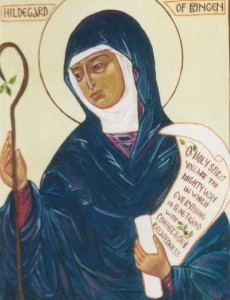 Once again the Holy Father, Pope Benedict XVI speaks of the importance of St. Hildegard of Bingen.
Once again the Holy Father, Pope Benedict XVI speaks of the importance of St. Hildegard of Bingen.
Vatican City – Pope Benedict’s General Audience from Vatican.va
Dear Brothers and Sisters, Today I would like to take up and continue my Reflection on St Hildegard of Bingen, an important female figure of the Middle Ages who was distinguished for her spiritual wisdom and the holiness of her life. Hildegard’s mystical visions resemble those of the Old Testament prophets: expressing herself in the cultural and religious categories of her time, she interpreted the Sacred Scriptures in the light of God, applying them to the various circumstances of life. Thus all those who heard her felt the need to live a consistent and committed Christian lifestyle. In a letter to St Bernard the mystic from the Rhineland confesses: “The vision fascinates my whole being: I do not see with the eyes of the body but it appears to me in the spirit of the mysteries…. I recognize the deep meaning of what is expounded on in the Psalter, in the Gospels and in other books, which have been shown to me in the vision. This vision burns like a flame in my breast and in my soul and teaches me to understand the text profoundly” (Epistolarium pars prima I-XC: CCCM 91). Hildegard’s mystical visions have a rich theological content. They refer to the principal events of salvation history, and use a language for the most part poetic and symbolic. For example, in her best known work entitled Scivias, that is, “You know the ways” she sums up in 35 visions the events of the history of salvation from the creation of the world to the end of time. With the characteristic traits of feminine sensitivity, Hildegard develops at the very heart of her work the theme of the mysterious marriage between God and humanity that is brought about in the Incarnation. On the tree of the Cross take place the nuptials of the Son of God with the Church, his Bride, filled with grace and the ability to give new children to God, in the love of the Holy Spirit (cf. Visio tertia: PL 197, 453c).
From these brief references we already see that theology too can receive a special contribution from women because they are able to talk about God and the mysteries of faith using their own particular intelligence and sensitivity. I therefore encourage all those who carry out this service to do it with a profound ecclesial spirit, nourishing their own reflection with prayer and looking to the great riches, not yet fully explored, of the medieval mystic tradition, especially that represented by luminous models such as Hildegard of Bingen.
The Rhenish mystic is also the author of other writings, two of which are particularly important since, like Scivias, they record her mystical visions: they are the Liber vitae meritorum (Book of the merits of life) and the Liber divinorum operum (Book of the divine works), also called De operatione Dei. In the former she describes a unique and powerful vision of God who gives life to the cosmos with his power and his light. Hildegard stresses the deep relationship that exists between man and God and reminds us that the whole creation, of which man is the summit, receives life from the Trinity. The work is centred on the relationship between virtue and vice, which is why human beings must face the daily challenge of vice that distances them on their way towards God and of virtue that benefits them. The invitation is to distance themselves from evil in order to glorify God and, after a virtuous existence, enter the life that consists “wholly of joy”. In her second work that many consider her masterpiece she once again describes creation in its relationship with God and the centrality of the human being, expressing a strong Christo-centrism with a biblical-Patristic flavour. The Saint, who presents five visions inspired by the Prologue of the Gospel according to St John, cites the words of the Son to the Father: “The whole task that you wanted and entrusted to me I have carried out successfully, and so here I am in you and you in me and we are one” (Pars III, Visio X: PL 197, 1025a). Finally, in other writings Hildegard manifests the versatility of interests and cultural vivacity of the female monasteries of the Middle Ages, in a manner contrary to the prejudices which still weighed on that period. Hildegard took an interest in medicine and in the natural sciences as well as in music, since she was endowed with artistic talent. Thus she composed hymns, antiphons and songs, gathered under the title: Symphonia Harmoniae Caelestium Revelationum (Symphony of the Harmony of Heavenly Revelations), that were performed joyously in her monasteries, spreading an atmosphere of tranquillity and that have also come down to us. For her, the entire creation is a symphony of the Holy Spirit who is in himself joy and jubilation.
The popularity that surrounded Hildegard impelled many people to seek her advice. It is for this reason that we have so many of her letters at our disposal. Many male and female monastic communities turned to her, as well as Bishops and Abbots. And many of her answers still apply for us. For instance, Hildegard wrote these words to a community of women religious: “The spiritual life must be tended with great dedication. At first the effort is burdensome because it demands the renunciation of caprices of the pleasures of the flesh and of other such things. But if she lets herself be enthralled by holiness a holy soul will find even contempt for the world sweet and lovable. All that is needed is to take care that the soul does not shrivel” (E. Gronau, Hildegard. Vita di una donna profetica alle origini dell’età moderna, Milan 1996, p. 402). And when the Emperor Frederic Barbarossa caused a schism in the Church by supporting at least three anti-popes against Alexander iii, the legitimate Pope, Hildegard did not hesitate, inspired by her visions, to remind him that even he, the Emperor, was subject to God’s judgement. With fearlessness, a feature of every prophet, she wrote to the Emperor these words as spoken by God: “You will be sorry for this wicked conduct of the godless who despise me! Listen, O King, if you wish to live! Otherwise my sword will pierce you!” (ibid., p. 412). With the spiritual authority with which she was endowed, in the last years of her life Hildegard set out on journeys, despite her advanced age and the uncomfortable conditions of travel, in order to speak to the people of God. They all listened willingly, even when she spoke severely: they considered her a messenger sent by God. She called above all the monastic communities and the clergy to a life in conformity with their vocation. In a special way Hildegard countered the movement of German cátari (Cathars). They cátari means literally “pure” advocated a radical reform of the Church, especially to combat the abuses of the clergy.
She harshly reprimanded them for seeking to subvert the very nature of the Church, reminding them that a true renewal of the ecclesial community is obtained with a sincere spirit of repentance and a demanding process of conversion, rather than with a change of structures. This is a message that we should never forget. Let us always invoke the Holy Spirit, so that he may inspire in the Church holy and courageous women, like St Hildegard of Bingen, who, developing the gifts they have received from God, make their own special and valuable contribution to the spiritual development of our communities and of the Church in our time.
Tags: catholic, catholic podcast, catholic prayer, cathollc spirituality, Church, courageous women, Hildegard of Bingen, holy spirit, mysteries, mystic of the Church, mystics, pope benedict, pope benedict xvi, st hildegard of bingen, women, women of the middle ages
This entry was posted on Wednesday, September 8th, 2010 at 4:08 pm
You can follow any responses to this entry through the RSS 2.0 feed.
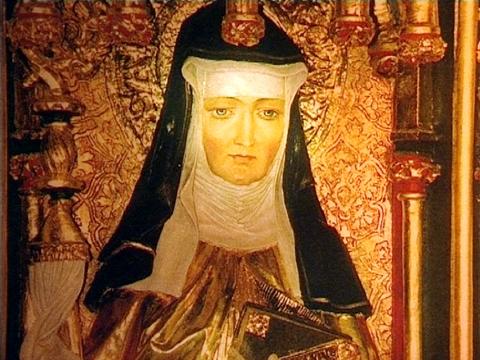 St. Hildegard was a woman who was a great mystic, writer, poet, musician, artist and a devout Benedictine nun!   She valued the hierachy and authority of the Church, and even sought counsel and received validation from the great mystical doctor of the Church, St. Bernard of Clairvaux.Â
St. Hildegard was a woman who was a great mystic, writer, poet, musician, artist and a devout Benedictine nun!   She valued the hierachy and authority of the Church, and even sought counsel and received validation from the great mystical doctor of the Church, St. Bernard of Clairvaux.Â
Papal Summer Residence, Castel Gandolfo
Wednesday, 1st September 2010“Saint Hildegard of Bingen
Dear Brothers and Sisters,
In 1988, on the occasion of the Marian Year, Venerable John Paul II wrote an Apostolic Letter entitled Mulieris Dignitatem on the precious role that women have played and play in the life of the Church. “The Church”, one reads in it, “gives thanks for all the manifestations of the feminine “genius’ which have appeared in the course of history, in the midst of all peoples and nations; she gives thanks for all the charisms that the Holy Spirit distributes to women in the history of the People of God, for all the victories which she owes to their faith, hope and charity: she gives thanks for all the fruits of feminine holiness” (n. 31).
Various female figures stand out for the holiness of their lives and the wealth of their teaching even in those centuries of history that we usually call the Middle Ages. Today I would like to begin to present one of them to you: St Hildegard of Bingen, who lived in Germany in the 12th century. She was born in 1098, probably at Bermersheim, Rhineland, not far from Alzey, and died in 1179 at the age of 81, in spite of having always been in poor health. Hildegard belonged to a large noble family and her parents dedicated her to God from birth for his service. At the age of eight she was offered for the religious state (in accordance with the Rule of St Benedict, chapter 59), and, to ensure that she received an appropriate human and Christian formation, she was entrusted to the care of the consecrated widow Uda of Gölklheim and then to Jutta of Spanheim who had taken the veil at the Benedictine Monastery of St Disibodenberg. A small cloistered women’s monastery was developing there that followed the Rule of St Benedict. Hildegard was clothed by Bishop Otto of Bamberg and in 1136, upon the death of Mother Jutta who had become the community magistra (Prioress), the sisters chose Hildegard to succeed her. She fulfilled this office making the most of her gifts as a woman of culture and of lofty spirituality, capable of dealing competently with the organizational aspects of cloistered life. A few years later, partly because of the increasing number of young women who were knocking at the monastery door, Hildegard broke away from the dominating male monastery of St Disibodenburg with her community, taking it to Bingen, calling it after St Rupert and here she spent the rest of her days. Her manner of exercising the ministry of authority is an example for every religious community: she inspired holy emulation in the practice of good to such an extent that, as time was to tell, both the mother and her daughters competed in mutual esteem and in serving each other.
During the years when she was superior of the Monastery of St Disibodenberg, Hildegard began to dictate the mystical visions that she had been receiving for some time to the monk Volmar, her spiritual director, and to Richardis di Strade, her secretary, a sister of whom she was very fond. As always happens in the life of true mystics, Hildegard too wanted to put herself under the authority of wise people to discern the origin of her visions, fearing that they were the product of illusions and did not come from God. She thus turned to a person who was most highly esteemed in the Church in those times: St Bernard of Clairvaux, of whom I have already spoken in several Catecheses. He calmed and encouraged Hildegard. However, in 1147 she received a further, very important approval. Pope Eugene iii, who was presiding at a Synod in Trier, read a text dictated by Hildegard presented to him by Archbishop Henry of Mainz. The Pope authorized the mystic to write down her visions and to speak in public. From that moment Hildegard’s spiritual prestige continued to grow so that her contemporaries called her the “Teutonic prophetess”.
This, dear friends, is the seal of an authentic experience of the Holy Spirit, the source of every charism: the person endowed with supernatural gifts never boasts of them, never flaunts them and, above all, shows complete obedience to the ecclesial authority. Every gift bestowed by the Holy Spirit, is in fact intended for the edification of the Church and the Church, through her Pastors, recognizes its authenticity.
I shall speak again next Wednesday about this great woman, this “prophetess” who also speaks with great timeliness to us today, with her courageous ability to discern the signs of the times, her love for creation, her medicine, her poetry, her music, which today has been reconstructed, her love for Christ and for his Church which was suffering in that period too, wounded also in that time by the sins of both priests and lay people, and far better loved as the Body of Christ. Thus St Hildegard speaks to us; we shall speak of her again next Wednesday. Thank you for your attention.”
God is the foundation for everything
This God undertakes, God gives.
Such that nothing that is necessary for life is lacking.
Now humankind needs a body that at all times honors and praises God.
This body is supported in every way through the earth.
Thus the earth glorifies the power of God.
Visit the Discerning Hearts
St. Hildegard von Bingen page
for more on this Doctor of the Church
Tags: Anglican Episcopal, catholic, catholic podcast, catholic prayer, cathollc spirituality, Church, holy father, Matthew Fox, mystic, mystic of the Church, mystical visions, New Agers, st bernard of clairvaux, st hildegard of bingen, st. hildegarde, Vatican Information Service, women of the middle ages
This entry was posted on Thursday, September 2nd, 2010 at 3:14 pm
You can follow any responses to this entry through the RSS 2.0 feed.
The Pope of the Blessed Sacrament
“Itching Ears Among Us
Saint Pius X exemplified the words of the Apostle to Timothy: “Preach the word, be urgent in season and out of season, convince, rebuke, and exhort, be unfailing in patience and in teaching. For the time is coming when people will not endure sound teaching, but having itching ears they will accumulate for themselves teachers to suit their own likings, and will turn away from listening to the truth and wander into myths†(2 Tim 4:2–4). One hundred years after Pope Saint Pius X we have to ask ourselves if there are not still “itching ears†among us.
What causes one’s ears to itch? Curiosity. Lack of discernment. A weak background in Catholic doctrine. Faithful Catholics cannot permit themselves to read just anything. To read authors of dubious orthodoxy or authors critical of the Magisterium is like scratching an itch. It becomes worse. Why would one would even want to read such authors when one can choose from among the inexhaustible richness of the writings of the saints of every age?
It was Saint Pius X who opened Holy Communion to little children. He invited the Catholic faithful to frequent, even daily Holy Communion. Pius X came to be known as the “Pope of the Eucharist,†a title that he now shares with Pope John Paul II, the author of Ecclesia de Eucharistia and of Mane Nobiscum, Domine.” – for more go to Vultus Christi
I see that serious face of the young boy to the right, and I wonder what he is thinking. His family was so poor. Giuseppe Melchiorre Sarto was born in 1835, the second of ten children. His father was the village postman. Though poor, his parents valued education and made every effort in securing that gift for their children.
Pope Pius was a Marian Pope, whose encyclical Ad Diem Illum expresses his desire through Mary to renew all things in Christ, which he had defined as his motto in his first encyclical. Pius believed that there is no surer or more direct road than by Mary to achieve this goal (no wonder he had such a beautiful heart). Pius X was the only Pope in the 20th century with extensive pastoral experience at the parish level, and pastoral concerns permeated his papacy; he favoured the use of the vernacular in catechesis. Frequent communion was a lasting innovation of his papacy. He spoke plainly and with strength, and because of that he was not well like by the elite and the rich.  He often referred to his own humble origins, taking up the causes of poor people. I was born poor, I have lived poor, and I wish to die poor
This is a wonderful prayer by the saint himself:
O Lord Jesus Christ, let Your passion be my strength to sustain, guard, and protect me. Let Your wounds be my food and drink to nourish, fill, and invigorate me. Let the shedding of Your Blood cleanse me of all my sins. Let Your death obtain eternal life for me and Your cross lead me to everlasting glory. Let these constitute for me refreshment and joy, health and uprightness of heart.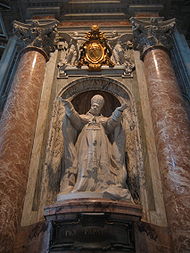 Â Â Amen.
  Amen.
Tags: Ad Diem Illum, catholic, catholic doctrine, catholic podcast, catholic prayer, cathollc spirituality, children, eternal life, holy communion, pope saint pius x
This entry was posted on Saturday, August 21st, 2010 at 7:03 am
You can follow any responses to this entry through the RSS 2.0 feed.
It’s always a rich joy to spend time with Fr. Alfred McBride. In ” A Priest Forever: Nine Signs of Renewal and Hope”, Father McBride brings forward not only his master catechetical skills, but hi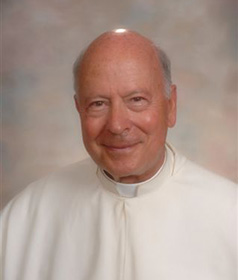 s deep love for the vocation he has lived all these many years. Though crisis may be rocking the Church with the current priest abuse scandals in other parts of the world, Fr. McBride helps us to see the rays of the Father’s  grace and mercy which are bringing about renewal and hope in the face of the storm.
s deep love for the vocation he has lived all these many years. Though crisis may be rocking the Church with the current priest abuse scandals in other parts of the world, Fr. McBride helps us to see the rays of the Father’s  grace and mercy which are bringing about renewal and hope in the face of the storm.
Fr. McBride’s book is published by
St. Anthony Messenger Press
Tags: abuse scandal, alfred mcbride, anthony messenger, catholic, catholic podcast, catholic prayer, cathollc spirituality, Father McBride, st anthony messenger press
This entry was posted on Wednesday, August 18th, 2010 at 8:14 pm
You can follow any responses to this entry through the RSS 2.0 feed.
The story of a modern day St. Augustine. Fr. Donald Calloway would blush at  the comparison, but the power found in his story of conversion and transformation is life changing for many who hear or read about it. And add in the influence of Our Lady, the Blessed Virgin Mary and watch out, you to may be drawn deeper into the heart of Christ and His Divine Mercy. A great read and a wonderful interview, with Fr. Calloway there is “No Turning Back”!
the comparison, but the power found in his story of conversion and transformation is life changing for many who hear or read about it. And add in the influence of Our Lady, the Blessed Virgin Mary and watch out, you to may be drawn deeper into the heart of Christ and His Divine Mercy. A great read and a wonderful interview, with Fr. Calloway there is “No Turning Back”!
Find Fr. Donald Calloway’s book or for more information go to www.fathercalloway.com
Tags: blessed virgin mary, calloway, catholic, catholic podcast, catholic prayer, cathollc spirituality, conversion, divine mercy, Donald Calloway, marian press, priesthood, st augustine, theology of the body, transformation
This entry was posted on Thursday, August 12th, 2010 at 3:11 pm
You can follow any responses to this entry through the RSS 2.0 feed.
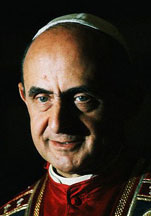
I was a junior in high school when Pope Paul VI died…was it really 32 years ago? Wow. It makes me sad to think it took so long for me to really appreciate and understand his legacy.

[powerpress url=”http://discerninghearts.com/Morning_Show/Karl_Schultz_Pope_Paul_VI.mp3″]Download (right click & choose “Save Link As”)
To really enter into his legacy, take a listen as Bruce and I discuss our late Holy Father w/ Karl Schultz, author of “Pope Paul VI: Christian Values and Virtures”, :
.
.
Tags: catholic, catholic podcast, catholic prayer, cathollc spirituality, humane vitae, karl schultz, pope paul vi
This entry was posted on Friday, August 6th, 2010 at 11:34 am
You can follow any responses to this entry through the RSS 2.0 feed.
Have you ever heard of “The Catholic Truth Society”? Well thanks to Ignatius Press, you  are about to. In this edition of “Inside the Pages”, I talk with Mark Brumley, president of Ignatius Press and whois one of the leading Catholic apologists in the country (he’s also a really nice guy as well). Ignatius Press is bringing the booklets, leaflets and tracks from the Society to America, and they’re fantastic. The authors found on these booklets are enough to crow about, but the titles are so good…wow…beyond excellent.  You don’t want to miss them. Take a look HERE! In this episode we talk the new evangelization, saints, history, apologetics…you name it.
are about to. In this edition of “Inside the Pages”, I talk with Mark Brumley, president of Ignatius Press and whois one of the leading Catholic apologists in the country (he’s also a really nice guy as well). Ignatius Press is bringing the booklets, leaflets and tracks from the Society to America, and they’re fantastic. The authors found on these booklets are enough to crow about, but the titles are so good…wow…beyond excellent.  You don’t want to miss them. Take a look HERE! In this episode we talk the new evangelization, saints, history, apologetics…you name it.
[powerpress]
Here are just some of the conversations Bruce and I have had with Mark Brumley in the past ![]()
Mark Brumley Did Jesus Really Rise.mp3
Mark Brumley Handbook of Catholic Apologetics.mp3
Mark Brumley Jesus of Nazareth Study Guide.mp3
Tags: catholic, catholic apologists, catholic podcast, catholic prayer, catholic truth society, cathollc spirituality, evangelization, ignatius press, inside the pages, mark brumley, mp3, new evangelization
This entry was posted on Thursday, July 22nd, 2010 at 10:26 am
You can follow any responses to this entry through the RSS 2.0 feed.

